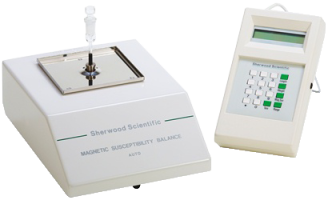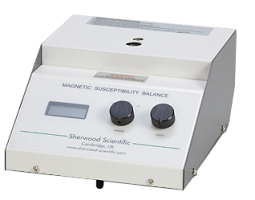MSB Auto
Magnetic Susceptibility is defined as:
“The ratio of the intensity of magnetism induced in a substance to the magnetizing force or intensity of field to which it is subject.”
Basic principles of magnetic behavior:
Based on their magnetic properties, all substances can be classified into one of three groups, those attracted by a strong magnetic field, known as paramagnetic, those repelled, designated, and, finally, the most recognized class, ferromagnetic, unique in their ability to retain their magnetic field. Ferromagnets can retain a permanent magnetic field since their free electrons are nearby and remain aligned even after the external magnetic field is removed.
Unlike the ferromagnets, the magnetic properties of the diamagnetic or paramagnetic materials could only be observed and measured when these samples were held within a magnetic field; and applied externally.
The Magnetic Susceptibility Balance – AUTO is a microprocessor-controlled, state-of-the-art, balance for detecting the magnetic properties of gases, liquids, and solids. The improved sensitivity, versatility, and overall performance make it ideally suited for new analytical applications in the research laboratory and industrial quality control.
Retaining all the advantages of our MK I instrument; the enhanced features of the Magnetic Susceptibility Balance AUTO are described:
• True portability:
This balance weighs just under 2.2 kg. and comes complete with a rechargeable battery which allows up to 8 hours of operation away from a mains power supply. Supplied in its robust carrying case the instrument can be fully operational in minutes after arrival at the analysis site. A travel clamp, external to the instrument and easy to apply, and an adjustable level control are the only setting-up procedures required.
• Efficiency and simplicity through microprocessor control:
The 8751 microprocessor has the balance calibration constant entered during manufacture. The digital display of the measurement is directly converted to Volume susceptibility in c.g.s. units without the need for calculation or manipulation. By entering the sample weight and length (internal sensors detect the diameter of the sample tube) Mass susceptibility can be read directly from the display. The instrument automatically zeroes when the sample tube is not in position, so it is always ready for use. An auto-tare facility can be implemented by simply pressing the Tare key with a blank tube in the sample position.
MSB MK1
Magnetic Susceptibility is defined as:
“The ratio of the intensity of magnetism induced in a substance to the magnetizing force or intensity of field to which it is subject.”
Basic Principles of Magnetic Behavior:
Based on their magnetic properties, all substances can be classified into one of three groups, those attracted by a strong magnetic field, known as paramagnetic, those repelled, designated diamagnetic, and finally, the most recognized class, ferromagnetic, unique in their ability to retain their own magnetic field. Ferromagnets are able to retain a permanent magnetic field since their free electrons are in close proximity and remain aligned even after the external magnetic field is removed.
Unlike the ferromagnets, the magnetic properties of the diamagnetic or paramagnetic materials could only be observed and measured when these samples were held within a magnetic field; and applied externally.
The MK 1 Magnetic Susceptibility Balance has proven to be the ideal instrument for use in teaching laboratories throughout the world where the reduced amounts of chemicals required for an experiment saves on material costs and minimizes waste product disposal.
Highlights:
Compared with the traditional Gouy balance methods the Sherwood Scientific MK 1 Magnetic Susceptibility Balance exhibits many advantages:
• Ease and speed of use. Place the sample tube in the balance and get an immediate digital read-out.
• Measurement can be made on a wide range of diamagnetic and paramagnetic materials.
• The fixed sample tube allows susceptibility measurement of solids, liquids, and gases.
• The technique has comparable sensitivity and is as accurate as traditional methods of measurement.
• The cost of the balance is significantly lower than a complete Gouy balance system.
• The instantaneous digital read-out can be used to calculate magnetic susceptibility using a simple equation. This gives significant time savings in both set-up and measurement.
• Small sample size – the balance normally works with a sample weight of around 250mg but, by using a thin-bore sample tube, as little as 50mg is required to give an accurate measurement.
• Analogue output. Using a flow cell allows a chemical reaction resulting in a change of susceptibility to be monitored dynamically. This allows new applications to be investigated, for example, redox reactions.
• The equipment is compact, lightweight, and hence easily portable. Only a 110V or 240V mains supply is required.





